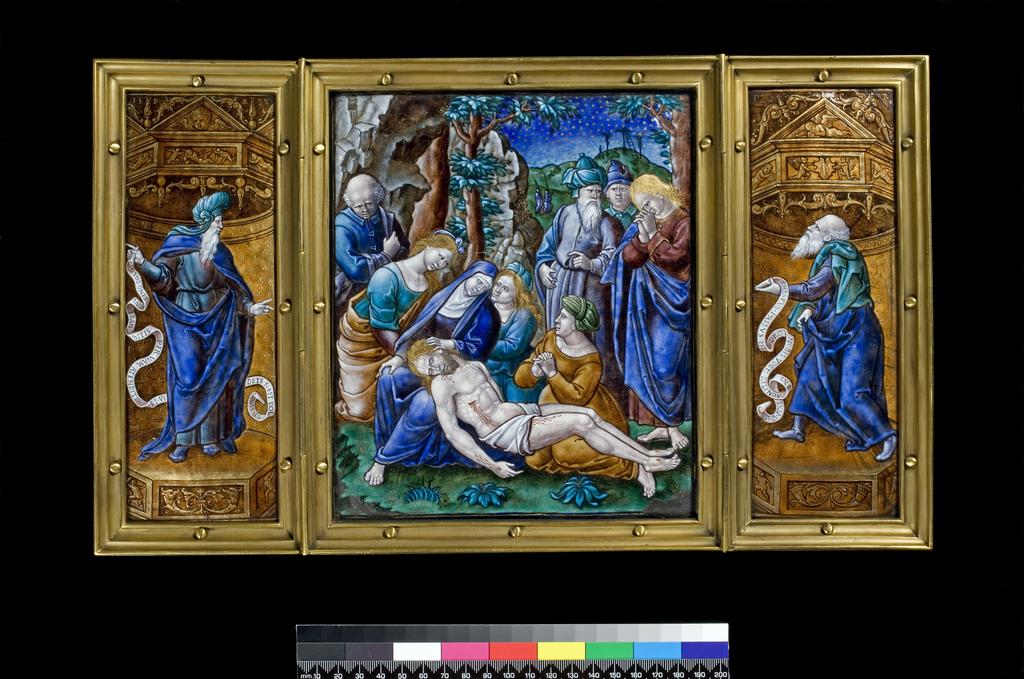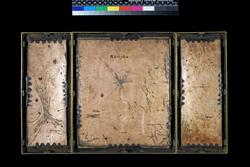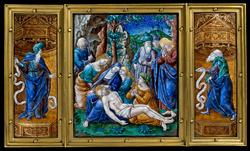Current Location: Gallery 32 (Rothschild)
Titles
The Lamentation with the Prophet Daniel and St Peter
Maker(s)
Maker:
Reymond, Pierre
Printmaker:
Raimondi, Marcantonio
(After)
Entities
Categories
Description
Copper, polychrome enamels, and gilding. Triptych comprising plaques of the Lamentation over the Dead Christ flanked by the Prophet Daniel and St Peter
Three slightly convex copper plaques with a white preparation, enamelled in blue, turquoise, green, flesh pink, mulberry, tan, brown, grey, black, and white, and gilded. The reverse has clear counter-enamel.
The central plaque shows the three Marys and the Virgin grieving over the dead Christ with St John standing on the right beside a tree, accompanied by an elderly bearded man, and a partly visible clean-shaven man, probably Joseph of Arimathea and Nicodemus; on the left, behind the Marys, is a partly visible bald-headed man. In the landscape background there are rocks and a tree on the left, and on the right, on Golgotha, a man, three crosses and a ladder propped against the one vacated by Christ. The sky is scattered with stars.
The Virgin wears a white wimple, a blue dress and blue cloak. The Mary to the left of her is dressed in a turquoise dress and pale brown cloak. The one nearest to her on the right wears a turquoise hat and dress, and the Mary further to the right, a green swathed cap and a tan dress. St John has a blue cloak over a mulberry gown. Joseph of Arimathea has a turquoise turban, and blue gown, and Nicodemus a blue hat and a turquoise jacket with a collar. The man on the left is dressed in a blue coat with a collar. In the foreground there are three turquoise plants on the green ground. Gold is used for the hair of Christ, two Marys and St John, to outline the edges of some of the garments, and ADD
On the left wing, the prophet Daniel stands on a hexagonal platform in a niche below an ornate canopy. He faces front, with his head in profile to the right, and holds a scroll inscribed in black,"O VOS.O(M)NES I.TRANSITIS.PERVIAM. ATENDITE.ET VIDETE. SI. EST. DOLOR.SIMI" (sic, the ending should be SICUT DOLOR MEUS) (O all of you who travel by the road, wait and see if there is such sorrow). He is bearded, and wears a greyish-turquoise turban, a gown of the same colour, and a blue cloak. The platform, niche, and canopy are tan with gilded details. The sides of the platform have two panels carved with nude figures, flanking one carved with two foliated scrolls terminating in monster heads. The canopy has a winged putto's head in the gable, and on the sides, three panels of nude figures. Above the gable there are pairs of foliated scrolls and at the top, divided by the apex of the gable,"15 P"and "R 38" inscribed in gold. The wall of the niche are scattered with fleur-de-lys, and level with the figure head have a cornice inscribed "DANIEL PROFETE"
On the right wing, an apostle, probably St Peter, stands in an analogous niche. He is shown in profile stepping towards the left holding a scroll inscribed "CHRISTVS. PASSVS. EST PRO. NOBIS.VOBIS RELINQVENS EXEMPLUN" (sic the last letter should be M)(Christ suffered for us, leaving for you an example). He is bald-headed and bearded, and wears a a long blue gown with a turquose shawl round his shoulders. The front of the platform is decorated with two panels carved with nude figures flanking one carved with a pair of foliated cornucopia. The gable of the canopy has a reclining putto, and on the sides below are two panels carved with reclining figures flanking one with two putti supporting a shield inscribed "Ihs". Above there are pairs of foliated scrolls and in the top corners "P" and "R" in gold. The niche are scatteed with groups of four dots on the right, and ? cross-hatched on the left, and at the top have a cornice decorated with a row of circles instead of an inscription.
Notes
History note: William Beckford (1760–1844), Fonthill Abbey; probably the triptych mentioned in catalogue of the cancelled sale, Magnificent Effects at Fonthill Abbey Wilts. to be sold by auction by Mr. Christie, 1 October 1822 and nine following days, p. 12, lot 87; by descent to Susan, Duchess of Hamilton, née Beckford (1786–1859), and her husband, Alexander, 10th Duke of Hamilton (1767–1852); by descent to the 12th Duke of Hamilton (1845–95); sold Christie’s, 17 June - 20 July 1882, Catalogue of the Collection of Pictures, Works of Art, and Decorative Objects the Property of His Grace the Duke of Hamilton, K.T., lot 971 (£1,218); W. Wareham; John Edward Taylor (1830–1905); his widow, Martha (d. 1912); Christie’s, 1-4 and 9-10 July 1912, Catalogue of the Renowned Collection of Works of Art . . . formed by the late John Edward Taylor, day 1, lot 142; Durlacher Bros, London; Frederick Leverton Harris (1864-1926), London.
Legal notes
Bequeathed by F. Leverton Harris
Triptychs were used as a focus for private devotions by religious and lay persons. When not in use the hinged wings could be folded over the central plaque to protect it. The exquisite execution, Raphaelesque style, and colouring of this example are characteristic of Pierre Reymond's early polychrome religious works dated in the late 1530s. The figures and architectural canopies on the wings are similar to those on a triptych with a central plaque of the Virgin and Child with Saints which he made for Louis de Bourbon (1495-1575), Abbess of Fontevrault in the same year, 1538, and is now in the Minneapolis Museum of Art (inv. 88.53).
The Lamentation was not described in the Gospels but was assumed to have taken place after Christ's body had been removed from the Cross, and before it was taken away for burial. The composition of the centre panel closely follows the engraving by Marcantonio Raimondi after Raphael of the 'Three Marys Lamenting the Dead Christ', although the enameller made some alterations to the heads of the man on the extreme left and the two Marys on either side of the Virgin. The inscription held by the Prophet Daniel is taken from the Lamentations of Jeremiah 1, 12, which if complete would read 'O all uou who travel by the road, wait and see if there is any sorrow like my sorrow'. This was an appropriate quotation for a wing flanking a scene from the Passion of Christ, because lessons from Lamentations were included in the tenebrae services which took place on the three days preceding Easter Sunday. The inscription on the scroll held by the other figure is from1 Peter 2,21, 'Christ suffered for us, leaving for you an example', which was equally appropriate. It also indicates that the figure is St Peter, although he does not hold a key, his usual attribute.
The triptych was acquired by the English collector, William Beckford (1760-1844) at an unknown date before 1822, possibly on one of his visits to France. The triptych's superb quality and Raphaelesque style would have appealed to Beckford's taste for High Renaissance art, as would its deeply moving religious subject. His small but splendid collection of Limoges painted enamels included an earlier triptych attributed to Nardon Pénicaud, now in the British Museum. On Beckford's death the Fitzwilliam's triptych was inherited by his daughter, Susan Euphemia (1786-1859), who had married Alexander, 10th Duke of Hamilton (1867-1852), who, like her father, was an ardent francophile, and art collector.

 IIIF Manifest
IIIF Manifest





